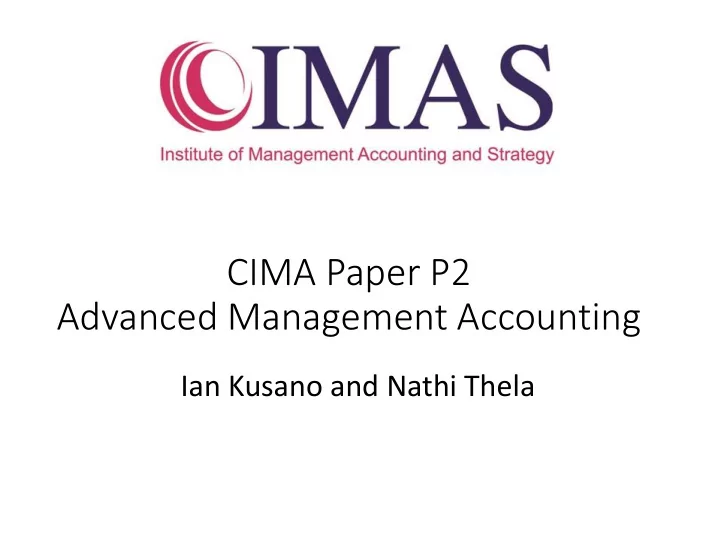

CIMA Paper P2 Advanced Management Accounting Ian Kusano and Nathi Thela
11 Chapter Further Aspects of Investment Appraisal 1
Chapter Content Relevant Cash Flows Risk Sensitivity Replacement Analysis Decisions Advanced Areas Capital Rationing Taxation Inflation 2
Uncertainty and Risk • Add premium for risk • Payback period • Sensitivity charts • Probability distribution 3
Sensitivity Analysis Sensitivity analysis in NPV questions typically involves posing ‘what if’ questions. The NPV is recalculated under different conditions, e.g. what would happen if demand fell by 10%, how would the result be affected if variable costs are 5% higher, etc. Alternatively, we may wish to discover the maximum possible change in one of the parameters before the opportunity becomes non-viable. This maximum possible change is often expressed as a percentage: NPV Sensitivity Margin = PV of Flow Under Consideration 4
March 2013 Exam A company is considering investing in manufacturing equipment that has a three year life. The purchase price of the equipment is $70,000 and at the end of the three year period it will be sold for cash of $10,000. The equipment will be used to produce 6,000 units each year of a product which earns a contribution per unit of $7. Incremental fixed costs are expected to be $12,000 per annum. The company has a cost of capital of 8% per annum. Ignore tax and inflation. Required: Calculate the sensitivity of the investment decision to a change in the cost of capital to 20%. 5
Example 1 BJS Ltd is considering investing $120,000 in equipment that has a life of 15 years. Its final scrap value is $25,000. The equipment will be used to produce 15,000 deluxe pairs of rugby boots per annum, generating a contribution of $2.75 per pair. Specific fixed costs are estimated at $18,000 per annum. The firm has a 15 % cost of capital. Required 1. Calculate the NPV of the project. 2. Calculate the sensitivity of your NPV to the: i. initial investment; annual contribution; annual fixed costs. 3. Identify the minimum annual sales required to ensure that the project at least breaks even. 6
Considerations in NPV Questions Relevant Cash Working Taxation Inflation Flows Capital 7
Relevant Cash Flow Investment decisions, like all other decisions, should be analysed in terms of cash flows that can be directly attributable to them. This has many implications: • Sunk Costs - A sunk cost has already been incurred and therefore will not be relevant to the investment decision. • Opportunity cost - As in all decision making, opportunity costs are relevant, and should be included in investment decisions. • Fixed costs - Should be treated as a whole, and only where relevant. This means that fixed overheads that are "absorbed"/ "charged"/ "allocated"/ "apportioned" to a project should be ignored. Only extra/incremental changes in fixed overheads should be included in discounted cash flow calculations. • Depreciation - Depreciation is not a cash flow, and so should never be included in a discounted cash-flow calculation. The only investment appraisal technique that will include depreciation is ARR 8
Example 2 & 3 9
Taxation Two Workings Corporation Tax Tax depreciation • 25% reducing • Net cashflows balance p.a. are taxable • Balancing allowance / • Timings given • CT rate given charge on disposal • Use separate working 10
Working Capital The treatment of working capital is as follows: • It is treated as an investment at the start of the project, like any other investment. • Working capital does not qualify for tax relief – so is ignored in the taxation and tax depreciation calculations. • At the end of the project the working capital is 'released'. This is treated as a cash inflow at the end of the project, equal to the total investment in working capital (unless told otherwise). 11
NPV Proforma Time 0 Time 1 Time 2 Time 3 $ $ $ $ Revenue X X Costs (X) (X) Net cash flow X X Tax on net (X) (X) (X) cash flow Investment (X) Scrap value X Tax dep’n X X X (X) X Working capital 12
NPV Proforma (cont.) Time 0 Time 1 Time 2 Time 3 $ $ $ $ Net cash flows (X) X X X Discount factor 1.00 x x x Present value PV PV PV PV 13
Inflation Must be Consistent ! • Real cashflows; without • Use real rate inflation • Money , or actual, • Use money , or cashflows; including nominal , rate inflation (1 + r)(1 + i) = (1 + m) 14
Other NPV Based Questions Asset Replacement Capital Rationing • Single period • Mutually exclusive • Divisible or not options with unequal • Multiple period lives • EAC • Example 11 • Optimum replacement cycle – Eg 10 15
Recommend
More recommend